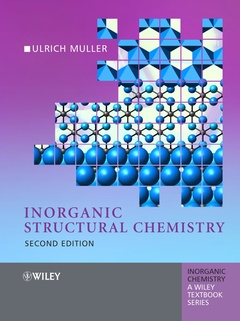Inorganic Structural Chemistry (2nd Ed.) Inorganic Chemistry: A Textbook Series
Auteur : Muller Ulrich

2. Description of Chemical Structures.
3. Symmetry.
4. Polymorphism and Phase Transition.
5. Structure, Energy and Chemical Bonding.
6. The Effective Size of Atoms.
7. Ionic Compounds.
8. Molecular Structures I: Compounds of Main Group Elements.
9. Molecular Structures II: Compounds of Transition Metals.
10. Molecular Orbital Theory and Chemical Bonding in Solids.
11. The Elements Structures of the Nonmetals.
12. Diamonds-like Structures.
13. Polyaniotic and Polycationic Compounds, Zintl Phases.
14. Packing of Spheres, Metal Structures.
15. The Sphere-packing Principle for Compounds.
16. Linked Polyhedra.
17. Packings of Spheres with Occupied Interstices.
18. Symmetry as the Organizing Principle for Crystal Structures.
19. Physical Properties of Solids.
20. Nanostructures.
21. Pitfalls and Linguistic Aberrations.
References.
Answers to the Problems.
Index.
Date de parution : 11-2006
Ouvrage de 280 p.
18.9x24.9 cm
Date de parution : 11-2006
Ouvrage de 280 p.
19.5x25.3 cm



